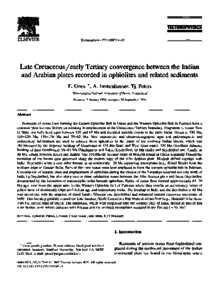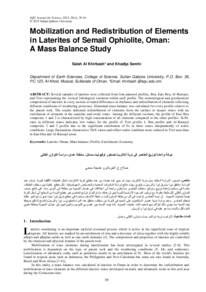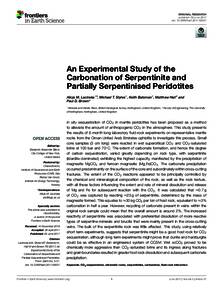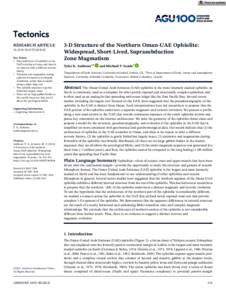وثيقة
Late cretaceous/early tertiary convergence between the Indian and Arabian plates recorded in ophiolites and related sediments.
المعرف
DOI: 10.1016/S0040-1951(96)00249-1
المصدر
Tectonophysics. v. 271, 1-2, p. 1-19
المساهمون
Immenhauser, A., مؤلف
Peters, Tj., مؤلف
الدولة
Netherlands.
مكان النشر
Amsterdam.
الناشر
Elsevier B. V.
ميلادي
1997-03-30
اللغة
الأنجليزية
الملخص الإنجليزي
Remnants of ocean floor forming the Eastern Ophiolite Belt in Oman and the Western Ophiolite Belt in Pakistan have a common plate-tectonic history culminating in emplacement at the Cretaceous/Tertiary boundary. Fragments of ocean floor in these two belts have ages between 150 and 65 Ma and recorded tectonic events in the early Indian Ocean at 150 Ma, 130-120 Ma, 110-100 Ma and 70-65 Ma. New radiometric and chronostratigraphic ages and paleomagnetic and sedimentary information are used to relocate these ophiolites in the frame of the evolving Indian Ocean, which was characterised by the stepwise breakup of Gondwana at 158 Ma (East and West Gondwana), 130 Ma (Southern Atlantic, breakup of East Gondwana), 95-84 Ma (Madagascar and India/Seychelles), 65 Ma (India and Seychelles) and, finally, at 40 Ma, rifting between Africa and Arabia. The 150-Ma-old oceanic rocks of Masirah Island in Oman originally formed the extension of the basins now preserved along the eastern edge of the Afro-Arabian plate. Masirah drifted together with India-Seychelles when a new ridge formed at approximately 130 Ma separating microplates (e.g., Kabul Block) from the northern edge of Greater India. Parts of this new ocean were later emplaced to form the western ophiolite belt in Pakistan. Consumption of oceanic crust and emplacement of ophiolites during the closure of the Neotethys occurred not only north of India (± Seychelles), but also along two or three subduction zones between the Afro-Arabian plate and India/Seychelles, documented by the formation of metamorphic soles beneath ophiolites. Relics of ocean floor formed approximately 65-70 Ma ago, now form the upper units in the Western Ophiolite belt of Pakistan where they overlie an accretionary prism of pillow lavas of dominantly (Aptian-) Albian age and sedimentary rocks. The breakup of India and the Seychelles at 65 Ma was associated with the eruption of flood basalts (Deccan and Seychelles) and enhanced counter-clockwise movement of India. This breakup possibly caused the Late Jurassic/Early Cretaceous fragments of ocean floor (e.g., Masirah) to be thrust onto the eastern edge of Oman. The ophiolites, which were emplaced onto the western edge of India, drifted as part of this plate farther north where collision with Eurasia and the accreted microplates occurred in the Eocene (∼ 55 Ma).
ISSN
0040-1951
قالب العنصر
مقالات الدوريات




